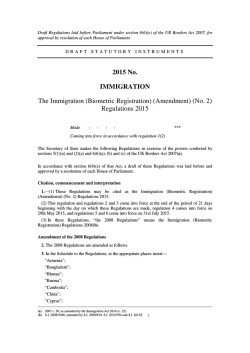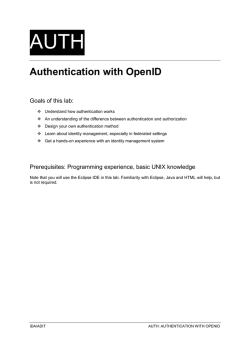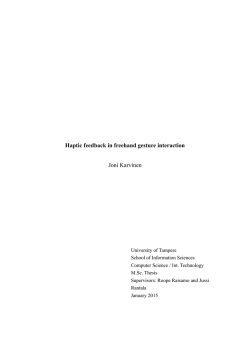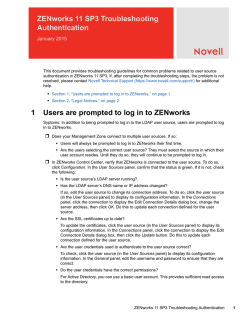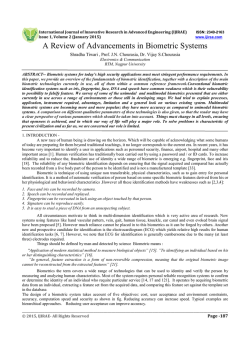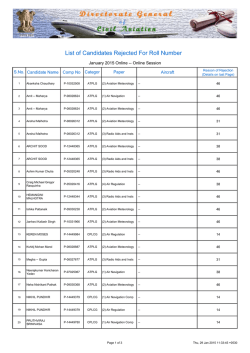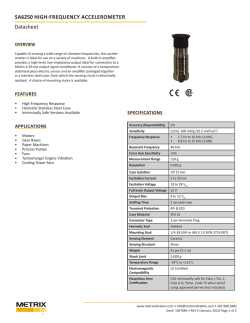
Motion-based Authentication for Wrist Worn Smart
MotionAuth: Motion-based Authentication for
Wrist Worn Smart Devices
Junshuang Yang*, Yanyan Li*, Mengjun Xie
Department of Computer Science
University of Arkansas at Little Rock
Little Rock, Arkansas, USA
Email: {jxyang2,yxli5,mxxie}@ualr.edu
Abstract—Wrist worn smart devices such as smart watches
become increasingly popular. As those devices collect sensitive
personal information, appropriate user authentication is necessary to prevent illegitimate accesses to those devices. However, the
small form and function-based usage of those wearable devices
pose a big challenge to authentication. In this paper, we study
the efficacy of motion based authentication for smart wearable
devices. We propose MotionAuth, a behavioral biometric authentication method, which uses a wrist worn device to collect a
user’s behavioral biometrics and verify the identity of the person
wearing the device. MotionAuth builds a user’s profile based on
motion data collected from motion sensors during the training
phase and applies the profile in validating the alleged user during
the verification phase. We implement MotionAuth using Android
platform and test its effectiveness with real world data collected
in a user study involving 30 users. We tested four different
gestures including simple, natural gestures. Our experimental
results show that MotionAuth can achieve high accuracy (as low
as 2.6% EER value) and that even simple, natural gestures such
as raising/lowering an arm can be used to verify a person with
pretty good accuracy.
I. I NTRODUCTION
Wearable smart devices, especially wrist worn devices such
as smart watch and activity tracker wristband, become increasingly popular following the huge success of smartphone. All
major smartphone vendors have released their smart watches
including Apple Watch, Samsung Galaxy Gear, LG G Watch,
etc. Those wrist worn devices usually carry multiple builtin sensors such as accelerometer and gyroscope sensors that
can measure movements and biosensors that can measure
heartbeat, skin temperature, respiratory rate, and other health
related information. The functionality and convenience of wrist
worn devices make it easy to collect sensitive personal data
unobtrusively and continuously. Therefore, securing device
accesses is necessary in order to protect data privacy.
On one hand, we need a mechanism to prevent unauthorized
access to a wrist worn device. Due to the small form factor,
those devices are prone to get stolen or lost. Current protection
available on those devices is rather weak and inconvenient.
For example, we can use PIN on smart watches. However,
the small screen of smart watch makes PIN input difficult and
error-prone. Therefore, no protection is applied in practice.
However, given that those devices are usually paired with
a smartphone through a wireless link (e.g., Bluetooth) for
* Both authors contributed equally to this work.
realizing richer functionality, weak or no authentication on
wrist worn devices not only endangers the privacy of user’s
data on device but also poses a significant threat to the security
of connected smartphone.
On the other hand, the plethora of sensors and transparent
data collection also provide an opportunity of securing the
device by the data it collects. As those collected data most
often are pertinent to a specific person (i.e., the device owner),
they can be used to build a profile of device owner, which
can then be used for verification purpose in case data access
is requested. For example, we can use kinetic data such as
accelerometer and gyroscope readings to construct the owner’s
behavioral biometric profile. Recently, many research efforts
have been devoted to user identification/verification based on
behavioral biometrics for smartphones (e.g., [6], [24], [15])
and their results indicate that behavioral biometric based
authentication is a viable means.
In this paper, we study the efficacy of motion based authentication for smart wearable devices. We propose MotionAuth,
a behavioral biometric based authentication method, to collect
a user’s behavioral biometrics through a wrist worn device
and verify the identity of the person wearing the device.
MotionAuth builds a user’s profile based on motion data
collected from motion sensors during the training phase and
applies the profile in validating the alleged user during the
verification phase. We apply two different verification methods, a histogram based method (Histogram) and a dynamic
time warping based method (DTW), to examine the accuracy
of MotionAuth. We implement MotionAuth using an Android
smart watch and test its effectiveness with real world data
collected in a user study involving 30 users. Four different
gestures are tested in which three are simple, natural gestures.
Our experimental results show that MotionAuth can achieve
high accuracy (as low as 2.6% EER value) and that the average
EER value of the four gestures is lower than 5% with either
of the two verification methods.
In summary, we have made the following contributions:
• We propose a behavioral biometric based authentication
framework—MotionAuth—for wrist worn smart devices.
MotionAuth exploits those devices’ innate capability of
continuous and transparent motion sensing to build a
behavioral biometric profile for the device’s owner. To our
best knowledge, MotionAuth is the first authentication
system that utilizes behavioral biometrics for wrist worn
smart devices.
• MotionAuth targets simple and natural gestures for authentication purpose. We have conducted preliminary
evaluation in which 30 volunteers participated. We applied two different methods—Histogram and DTW–for
verification and the experimental results are promising.
The rest of this paper is organized as follows: Section
II briefly describes the background of behavioral biometrics
and related work. Sections III and IV present the design
of MotionAuth and its prototype implementation. Section V
details the evaluation including the method for data collection
and the analysis of experimental results. Section VI briefly
discusses the future work and concludes this paper.
II. BACKGROUND AND R ELATED W ORK
User authentication refers to the process in which a user
submits her identity credential (often represented by paired
username and password) to an information system and validates to the system that she is who she claims to be. In general,
there are three types of authentication factors: something a user
knows (e.g., a password), something a user has (e.g., a secure
token), and something a user is (e.g., biometric characteristics).
Passwords are the most common authentication mechanism.
However, password-based authentication has many security
issues [8], [11], [4] and is not suitable for wrist worn devices.
In general, a biometric authentication system verifies a
person based on either his/her physiological traits (e.g., fingerprint, face, voice, iris, bioimpedance, etc) [12], [2], [5] or
behavioral biometrics (e.g., finger or hand movements) [25],
[6]. Thanks to rich sensing capabilities, both physiological and
behavioral biometrics can be easily collected on today’s smart
mobile devices. While physiological traits can achieve high
accuracy in user authentication, they are subjected to a variety
of attacks [14], [20], [21] and also raise privacy concerns
[19]. Moreover, accuracy of physiology-based mechanisms
may be substantially degraded by environmental factors such
as viewing angle, illumination, and background noise [13],
[3]. In contrast, behavioral biometrics appear less sensitive to
ambient light or noise.
The popularity of mobile devices especially smartphones
and tablets have attracted a great deal of research efforts
to investigate how to effectively apply behavioral biometrics
to mobile device authentication. Researchers have studied
behavioral biometric features extracted from regular touch
operations [7], [23], unlock pattern and PIN operations [6],
[24], and multitouch gestures [15], [17], [18].
Activity and gesture recognition has been extensively studied based on sensing data from accelerometer and some other
sensors such as gyroscope on a mobile device. Kwapisz et al.
used a single wrist-worn accelerometer to recognize and classify human activities such as sitting, walking and running and
their method can achieve accuracy of more than 94.13% [9].
In [22] and [1], accelerometer based approaches for gesture
classification are presented in which a 3-axis accelerometer
was used to recognize hand movement gestures. Liu et al.
Fig. 1. Overview of MotionAuth Authentication Process.
proposed uWave, an accelerometer-based gesture recognition
system [10]. They conducted a comprehensive analysis on
accelerometer-based gesture recognition using Wii remote and
studied both simple gestures and personalized gestures. uWave
can also be applied to gesture-based authentication. Similar to
our work, uWave uses 3D freestyle movement as a gesture
for authentication. However, as reported in [10] while using
complex personalized gestures can achieve high accuracy in
authentication, gestures from simpler gesture group have lower
accuracy. Our work focuses on simple, natural gestures that
can be more practical in real-world deployment and shows
that high verification accuracy can still be achieved.
III. S YSTEM D ESIGN
MotionAuth is designed as a behavioral biometric authentication framework for personal wrist worn smart devices
(or simply “the device(s)” when context is clear). As monitoring human activities is one of primary applications for
such devices, built-in motion sensors (i.e., accelerometer and
gyroscope) in those devices continuously collect the device
user’s motion data. MotionAuth leverages the motion data
collected during the personal gesture for verification being
performed. It first builds a profile for the device owner and
later verifies the device user with that profile.
MotionAuth imposes no constraint on the form of gesture,
that is, simple gestures can be applied as well as complex
ones although more complex, uncommon gestures generally
can render higher discernibility. The design of MotionAuth
is strongly motivated by a simple idea: verifying a user with
simple, natural gestures that are often performed; therefore
average people do not need to remember their verification
gesture and can perform it effortlessly and consistently. To
examine this idea, we selected three natural gestures plus a
special one and asked volunteers to perform them in evaluating
the prototype of MotionAuth, which is detailed in Section V.
To use MotionAuth, the owner of a wrist worn device
(we assume the owner is also the device user) first needs
to take a training process, in which the person performs the
gesture selected for verification a number of times with the
arm wearing the device and his or her behavioral biometric
profile is built from the readings of motion sensors collected
while performing each gesture. Then, when user verification
is invoked, the motion data of the gesture performance will be
compared with the user profile to verify the user’s authenticity.
Fig. 1 depicts the overall process of authentication using
MotionAuth.
As illustrated in Fig. 1, there are four important modules
in the MotionAuth framework: data acquisition, feature extraction, template generation, and matching. In the data acquisition
module, raw data are collected from motion sensors during
gesture performance and stored into a database that is either
local or remote. In the feature extraction module, a set of
features are derived from raw sensor data and fed into the
template generation module. In that module, each gesture
sample is represented by a feature vector after applying certain
transformation, and a template for each user is generated from
feature vectors derived from the user’s training samples. The
matching module takes the user’s template (selected based on
the claimed identity) and features extracted from a test sample
and applies certain matching algorithm to decide whether the
test sample can be accepted as genuine. As can be seen,
the overall design of MotionAuth is quite general and can
be realized by different matching schemes for behavioral
biometric verification.
There are two types of verification techniques that are
commonly used in biometric based authentication. They are
function based methods such as dynamic time warping (DTW)
algorithm and hidden Markov models (HMM) and feature
based methods that use descriptive features of the biometric.
We consider both types of techniques for MotionAuth; We
choose DTW as the representative function based method
and a histogram method, which is shown effective for online
signature verification in [16], as the representative feature
based method. DTW has been widely used in various studies
on behavior biometric authentication [6], [10]. As gestures
can be treated as a freestyle 3D signature written with arm, it
would be interesting to apply the histogram method (or simply
Histogram) to gesture-based verification.
Both Histogram and DTW use the same data acquisition
process. Data collection from accelerometer and gyroscope
(we currently only use these two sensors due to their ubiquity in smart wearable devices) begins when a user starts
the gesture and ends when the user finishes it. Given three
dimensional data for both accelerometer and gyroscope, total
six raw time series are generated when performing each
gesture. In the rest of the section, we first present the threat
model for MotionAuth, then briefly describe the Histogram
and DTW methods, and finally discuss issues of deploying
the MotionAuth framework.
A. Threat Model
In the threat model for MotionAuth, we assume that an
adversary attempts to gain illegitimate access to protect applications or data on the device by launching mimicry attacks,
that is, the adversary already knows the gesture for authentication and pretends to be the device’s owner by performing that
gesture. We assume the adversary does not seek to gain access
to the data stored on the device through network-based attacks
or other means. We also assume that the attacker can only
make up to a specific number of attempts for authentication.
If all attempts fail, the predefined protection mechanism, e.g.,
encrypting all the data on device, will be invoked.
TABLE I
PART OF THE HISTOGRAMS USED IN M OTIONAUTH
Histogram
M
Min
µ − 3σ
Max
µ + 3σ
Bin #
16
θx
−Π/2
Π/2
16
θy
−Π/2
Π/2
16
θz
−Π/2
Π/2
16
Description
Magnitude of acceleration.
√
M = AX 2 + AY 2 + AZ 2
Angle between magnitude and
X-axis. θx = arccos(AX/M )
Angle between magnitude and
Y -axis. θy = arccos(AY /M )
Angle between magnitude and
Z-axis. θz = arccos(AZ/M )
B. Histogram Method
1) Feature Extraction: First, from six raw readings of 3axis acceleration (from accelerometer) and angular velocity
(from gyroscope), we derive 30 features in total: three accelerations and three angular velocities (in X, Y , Z) and their
corresponding first and second derivatives (total 18 features),
the magnitude of acceleration M , the three angles between
M and X/Y /Z (denoted as θx , θy , and θz ) and their corresponding first and second derivatives (total 12 features). Table
I gives more details about M and θx , θy , and θz . Each feature
is represented by a vector denoted as V = {vi |i = 1, 2, ..., n}.
We use V 0 and V 00 to denote the first and second derivatives
of V respectively, where V 0 = {vi0 |vi0 = vi+1 − vi , i =
0
1, 2, ..., n − 1}, V 00 = {vi00 |vi00 = vi+1
− vi0 , i = 1, 2, ..., n − 2}.
To simplify, accelerations in X, Y , Z are denoted as AX, AY ,
AZ respectively, and their derivatives as AX 0 , AY 0 , AZ 0 ,
AX 00 , AY 00 , and AZ 00 . These derivatives reflect the change
rate and change acceleration of specific attributes.
Then, each vector is converted to a probability distribution
histogram through binning. We create a given number of
equidistant histogram bins with the given min and max values
of the histogram and put each element of the vector into those
bins. We then calculate the frequency of each bin by dividing
the number of elements falling into that bin by the total number
of elements. Let bi be a frequency value for bin i. A feature
vector Bj (1 ≤ j ≤ 30) is represented by concatenating the
bin frequency values for feature j, i.e., Bj = {bj1 ||bj2 ||...||bjjm },
where jm is the number of bins. Finally, a gesture sample is
represented by concatenating all the feature vectors Bj into
a single feature vector F , i.e., F = {B1 ||B2 ||...||B30 } =
30
30
{b11 ||b12 ||...||b11m ||...||b30
1 ||b2 ||...||b30m }.
2) Template Generation: A user’s template for a given
gesture is generated from the feature set derived from training
samples of that gesture. Since each gesture sample is represented by a feature vector Fi , we have a sequence of vectors
F1 , F2 , ...Fk from k training samples. For each Fi , 1 ≤ i ≤ k,
Fi = {f1i ||f2i ||...||fni }, where fji (1 ≤ j ≤ n, n = 1m + 2m +
... + 30m) is a frequency value. The template Ft is defined as
Ft = {f1t ||f2t ||...||fnt }, where
fjt =
avg(fj1 , fj2 , ..., fjk )
std(fj1 , fj2 , ..., fjk ) + , 1 ≤ j ≤ n,
and is a small value 0.002 to prevent division by zero.
The feature vector Ft and standard deviation vector Q =
{std(f11 , f12 , ..., f1k )||std(f21 , f22 , ..., f2k )||...||std(fn1 , fn2 , ..., fnk )}
are stored as the user’s profile for verification purpose.
3) Matching: To verify the claimed user, given a testing
gesture sample Fs , the similarity distance score Dsim is
calculated P
using Manhattan Distance between Ft and Fs .
n
t
s
Dsim =
i=1 |fi − fi /Qi |. If the score is less than a
predefined threshold the sample is accepted and the person
who performed the gesture passes the verification. Otherwise,
the sample is rejected.
C. DTW Method
1) Feature Extraction: The DTW method extracts the same
set of features as the Histogram method does, but its data
representation of samples is different. All samples in DTW
are represented using original time series. Assume n features
(n is 30 in our case) are extracted from a sample with length
(i.e., the number of time points) m, the sample is represented
as a n × m matrix.
2) Template Generation: Let S and T rain be a training
sample and the set of training samples, respectively. We
use min(d(S, T rain − {S})) to denote the minimum DTW
distance between S and all the other training samples. First,
we calculate DTW distances between every pair of training
samples to derive the average of minimum DTW distances
avg(Dmin ), where Dmin = {min(d(S, T rain − {S})) :
S ∈ T rain}. Then, we identify a training sample T that
has the minimal sum of the DTW distances to the other
training samples. This sample is used as the user’s gesture
template. The minimum DTW distance between T and the
rest of training samples, min(d(T, T rain − {T })), is saved
along with avg(Dmin ) as the user profile.
3) Matching: Assume sample S 0 is collected for the user
to be verified. We compute the similarity score Dsim between
sample S 0 and template T .
min(d(S 0 , T rain)) − min(d(T, T rain − {T })) Dsim = avg(Dmin )
where d(S 0 , T rain) returns the set of DTW distances between
S 0 and each training sample. The testing sample S 0 will
be accepted if Dsim is lower than the predefined threshold;
otherwise it will be rejected.
D. Discussion
Given the variation of wrist worn smart devices in terms of
their form, user interface, and usage, the actual implementation of MotionAuth may vary. For example, for those smart
watches, the entire authentication process can be performed
on the smart watch; or the computation can be executed on
the smartphone if the watch is used as a companion of the
phone. The protection of MotionAuth can present as a screen
lock that is unlocked by a user specified gesture. For activity
tracking bands that do not have a visual interaction interface,
MotionAuth may use vibration or sound as the means for
indication of verification result. For those devices without
any user interaction interface, MotionAuth could attach the
verification result as auxiliary information to sensor data
so that the result can be viewed later when the data are
synchronized to another device for review.
IV. I MPLEMENTATION
We implemented a prototype of MotionAuth on Android
platform. For ease of evaluation, the Android application of the
current prototype is used as front end to collect data and all the
computations are performed on a back end PC. The application
was developed for smart watches that run on Android 4.x or
upper version platforms and carry built-in accelerometer and
gyroscope sensors. Figure 2 shows the user interface of the
application.
(a)
(b)
(c)
Fig. 2. Android app for data collection in the prototype
The main user interface (UI), shown in Fig. 2 (a), has a user
identity (ID) selector and lists four gestures each requiring
a user to perform 10 times. The detail of the gestures is
given in Section V. When using the app to collect data,
a user first selects his or her assigned ID and then clicks
each gesture button in turn to perform those gestures. Once
a gesture trial (10 actions) is completed, the button for that
gesture is disabled. To make data collection more accurately,
a user needs to explicitly press the “start” button (Fig. 2
(b)) and “stop” button (Fig. 2 (c)) to indicate the beginning
and end of the gesture, respectively. The app uses Android
sensor framework, specifically the SensorManager class,
to access accelerometer and gyroscope readings, register and
unregister sensor event listeners, and acquire sensor data
at a specific delay acquisition rate. In the app we set the
delay rate as SENSOR_DELAY_FASTEST, which may vary
on different hardware. The rate is 100 Hz (±3 Hz) on
our testing smart watch (Samsung Galaxy Gear), i.e., sensor
readings are recorded every 10 milliseconds. Readings of 3axis accelerometer and gyroscope as well as corresponding
timestamps are recorded during gesture being performed and
saved to specified files at the end of each gesture.
To facilitate analysis and evaluation, we developed a data
processing suite in Matlab that implements all the modules
of the MotionAuth framework. Extending the prototype to
a comprehensive Android application that realizes the entire
MotionAuth framework including verification will be our
future work.
V. E VALUATION
A. Data Collection
We conducted a user study to evaluate the viability of
MotionAuth. We recruited 30 volunteers (24 males and 6
females) to participate in the study that spanned from June
to Sept. in 2014. Among them, 7 are high school students, 20
are undergraduate or graduate students, 3 are college faculty.
(a) Circle (I)
(b) Down (II)
(c) Up (III)
(d) Rotation (IV)
Fig. 3. Illustration of the four gestures.
TABLE II
EER (%) OF THE H ISTOGRAM (H) AND DTW (D) METHODS ( LEAVE - ONE - OUT CROSS VALIDATION )
Gesture
I (H)
I (D)
II (H)
II (D)
III (H)
III (D)
IV (H)
IV (D)
U1
2.6
2.5
0.0
0.0
2.2
3.2
0.0
0.0
U2
0.6
2.8
7.1
4.8
2.8
7.0
2.7
2.6
U3
5.3
2.5
1.9
1.5
2.7
3.6
0.0
0.0
U4
11.3
5.7
5.0
0.0
5.9
0.0
14.4
2.9
U5
2.4
2.4
2.7
2.1
0.0
0.0
5.5
2.3
U6
2.5
7.4
1.6
3.0
0.1
9.7
2.5
17.9
U7
7.0
7.3
5.1
6.8
7.9
10.6
5.0
15.2
U8
2.4
0.1
2.3
0.8
3.1
4.9
2.9
2.1
U9
5.7
10.8
8.3
7.9
1.9
2.9
11.1
18.9
U10
5.9
9.8
10.5
9.9
2.2
5.1
0.2
10.7
U11
2.8
2.6
0.3
0.0
1.4
5.6
5.0
4.8
U12
2.3
7.2
5.3
5.1
4.5
3.1
18.2
7.7
The ages of participants range from 19 to 48. The study was
reviewed and approved by the IRB of the authors’ institution.
In the study each participant was asked to wear a Samsung
Galaxy Gear smart watch and use the arm wearing the watch to
perform the same set of 4 designated gestures each 10 times
in one trial of experiment. Each participant was required to
repeat the entire experiment 3 times, each in a different day.
Actual intervals between two consecutive experiments span 3
to 7 days.
We assigned a unique integer to each participant as their
ID to protect participants’ privacy. At the beginning of data
collection, we illustrated the testing gestures to each participant. Note that we do not ask participants to follow the demo
gestures exactly. Instead, they were encouraged to perform
those gestures in their own natural and comfortable manner.
For example, different participants could make a “circle”
gesture in different speed and shape.
One important question is what gestures should be tested
for this study? As our ultimate goal is to deploy MotionAuth
in real world where people often forget their authentication
credentials, we set the following criteria for our gesture selection: natural and simple. We selected 3 simple gestures: arm
down (marked as Down), arm up (Up), forearm rotation about
90 degree clockwise (Rotation). We also considered a more
complex gesture commonly studied in gesture recognition,
Drawing-A-Circle (Circle), as a complement to these simple
gestures. The 4 gestures are illustrated in Fig. 3.
B. Data Analysis
We use false acceptance rate (FAR), false rejection rate
(FRR), and equal error rate (EER) as the metrics for the
evaluation. FAR measures the likelihood of an unauthorized
user being incorrectly accepted while FRR measures the
likelihood of an authorized user being incorrectly rejected.
EER is the rate when FAR and FRR are equal at a certain
threshold value. In general, the lowest EER indicates the most
accurate authentication decision. We evaluate authentication
U13
0.6
8.6
2.0
6.9
2.1
17.0
2.8
19.8
U14
0.1
0.5
2.2
4.8
3.4
2.4
1.8
4.5
U15
6.7
7.7
8.7
10.4
9.2
13.2
22.7
23.0
U16
0.0
0.0
0.1
2.1
0.1
3.0
2.6
3.0
U17
2.5
5.8
7.1
10.3
9.3
11.3
5.8
10.7
U18
0.4
0.0
0.0
0.8
0.1
0.6
0.6
9.9
U19
0.1
2.3
2.4
2.1
7.2
2.2
0.2
4.3
U20
0.2
3.8
0.3
4.7
2.6
0.0
0.1
1.9
U21
0.0
1.3
7.1
4.3
2.4
9.9
7.4
21.2
U22
1.9
2.1
1.0
9.2
4.9
4.8
4.9
14.4
U23
2.4
2.0
0.0
0.1
0.0
0.0
0.6
0.2
U24
2.4
3.6
0.4
1.8
0.1
2.9
4.3
3.0
U25
0.0
1.7
0.4
4.9
0.0
0.0
0.2
0.4
U26
0.0
0.0
0.0
0.0
0.0
0.5
0.0
0.4
µ±σ
2.6 ± 2.8
3.8 ± 3.2
3.1 ± 3.2
4.0 ± 3.5
2.9 ± 2.9
4.7 ± 4.6
4.7 ± 5.8
7.7 ± 7.5
accuracy of MotionAuth in terms of EER for all the 4
gestures. As 4 out of 30 participants did not complete all
the required experiments, their gesture data are not included
in the evaluation. We collected 40 samples from each of the
remaining 26 participants (i.e., the “users”) for each gesture
and in total 4,160 gesture samples are used in our evaluation.
To measure a gesture’s FRR for each user, we use leaveone-out cross validation to test that user’s samples of the
gesture. To measure a gesture’s FAR for each user, all other
users’ samples of that gesture are treated as impostors’ gesture
samples and are tested against the genuine user’s template. All
testing results are represented by similarity scores from which
we calculate FAR and FRR and derive EER.
Table II shows the EER value (in %) for each user and each
gesture obtained by using the Histogram and DTW methods.
We can see that MotionAuth achieves very high accuracy
(close to 0 EER) in verification for some users (e.g., U26 ). For
all four gestures, a gesture’s average EER value given by the
Histogram method is smaller than that attained by the DTW
method although two methods’ accuracy varies per individual
user. Among the four gestures, Circle achieves the lowest
EER (2.6% mean for Histogram and 3.8% for DTW) while
Rotation gives the highest EER (4.7% mean for Histogram
and 7.7% for DTW). Surprisingly, even simple Down and Up
gestures can achieve pretty good accuracy (no more than 5%
on average) and the accuracy of Down is closely comparable
to that of Circle. This may be explained by the fact that
both Down and Up use the whole arm while Rotation only
uses the forearm, which makes it less random and unique.
Some users such as U15 have much higher EER values across
all four gestures, which suggests that some users may have
difficulty in performing certain gestures consistently assuming
no bias or error introduced in data collection. Overall, small
EERs achieved by two different methods make it promising
to apply MotionAuth in practice and motivate us to explore
better verification techniques.
Figure 4 shows the EER distribution of each gesture for
Fig. 4. User Distribution of EER for both Histogram and DTW
both the Histogram and DTW methods. It is very clear that
the higher the proportion of users with large EER values (more
than 10%), the worse the gesture’s accuracy is. In general, the
majority of user’s EER values are lower than 5% for all the
tested gestures.
VI. C ONCLUSION
In this paper, we presented a motion based user authentication scheme called MotionAuth for effectively verifying
a person wearing a wrist worn smart device. Compared
to conventional PIN or password based authentication, We
applied two distinct algorithms—Histogram and DTW—for
verification and implemented MotionAuth based on Android
platform. We conducted a user study in which 30 people
were involved. Our experimental results show that simple,
natural gestures can achieve EER values lower than 5%. As an
ongoing study, we will continue the investigation of gesture
testing, algorithm design, and mobile application development
with a large-scale system assessment in future.
R EFERENCES
[1] A. Akl, C. Feng, and S. Valaee. A novel accelerometer-based gesture recognition system. IEEE Transactions on Signal Processing,
59(12):6197–6205, 2011.
[2] E. T. Anzaku, H. Sohn, and Y. M. Ro. Privacy preserving facial and
fingerprint multi-biometric authentication. In Proc. the 9th Intl. Conf.
on Digital watermarking, IWDW’10, pages 239–250, 2011.
[3] F. Bimbot, J.-F. Bonastre, C. Fredouille, G. Gravier, I. MagrinChagnolleau, S. Meignier, T. Merlin, J. Ortega-Garc´ıa, D. PetrovskaDelacr´etaz, and D. A. Reynolds. A tutorial on text-independent speaker
verification. EURASIP J. Appl. Signal Process., 2004:430–451, Jan.
2004.
[4] J. Bonneau, C. Herley, P. C. v. Oorschot, and F. Stajano. The quest
to replace passwords: A framework for comparative evaluation of web
authentication schemes. In Proc. the 2012 IEEE Symposium on Security
and Privacy, pages 553–567, 2012.
[5] C. Cornelius, R. Peterson, J. Skinner, R. Halter, and D. Kotz. A wearable
system that knows who wears it. In Proc. MobiSys ’14, pages 55–67,
2014.
[6] A. De Luca, A. Hang, F. Brudy, C. Lindner, and H. Hussmann. Touch
me once and i know it’s you!: Implicit authentication based on touch
screen patterns. In Proc. CHI ’12, pages 987–996, 2012.
[7] M. Frank, R. Biedert, E. Ma, I. Martinovic, and D. Song. Touchalytics:
On the applicability of touchscreen input as a behavioral biometric for
continuous authentication. IEEE Transactions on Information Forensics
and Security, 8(1):136–148, 1 2013.
[8] D. V. Klein. Foiling the cracker: A survey of, and improvements to,
password security. In Proc. the 2nd USENIX Security Workshop, pages
5–14, 1990.
[9] J. R. Kwapisz, G. M. Weiss, and S. A. Moore. Activity recognition
using cell phone accelerometers. SIGKDD Explor. Newsl., 12(2):74–82,
Mar. 2011.
[10] J. Liu, L. Zhong, J. Wickramasuriya, and V. Vasudevan. uWave:
Accelerometer-based personalized gesture recognition and its applications. Pervasive Mob. Comput., 5(6):657–675, Dec. 2009.
[11] A. Narayanan and V. Shmatikov. Fast dictionary attacks on passwords
using time-space tradeoff. In Proc. the 12th ACM Conf. on Computer
and Communications Security, pages 364–372, 2005.
[12] H. S. Own, W. Al-Mayyan, and H. Zedan. Biometric-based authentication system using rough set theory. In Proc. the 7th Intl. Conf. on Rough
sets and current trends in computing, RSCTC’10, pages 560–569, 2010.
[13] P. Phillips, J. Beveridge, B. Draper, G. Givens, A. O’Toole, J. Bolme,
D.; Dunlop, Y. M. Lui, H. Sahibzada, and S. Weimer. An introduction
to the good, the bad, & the ugly face recognition challenge problem.
In Proc. the IEEE Intl. Conf. on Automatic Face Gesture Recognition,
pages 346–353, 2011.
[14] N. Ratha, J. Connell, and R. Bolle. Enhancing security and privacy
in biometrics-based authentication systems. IBM Systems Journal,
40(3):614–634, 2001.
[15] N. Sae-Bae, K. Ahmed, K. Isbister, and N. Memon. Biometric-rich
gestures: A novel approach to authentication on multi-touch devices. In
Proc. CHI ’12, pages 977–986, 2012.
[16] N. Sae-Bae and N. Memon. Online signature verification on mobile
devices. IEEE Transactions on Information Forensics and Security,
9(6):933–947, June 2014.
[17] M. Shahzad, A. X. Liu, and A. Samuel. Secure unlocking of mobile
touch screen devices by simple gestures: You can see it but you can not
do it. In Proc. the 19th Annual Intl. Conf. on Mobile Computing and
Networking, MobiCom ’13, pages 39–50, 2013.
[18] M. Sherman, G. Clark, Y. Yang, S. Sugrim, A. Modig, J. Lindqvist,
A. Oulasvirta, and T. Roos. User-generated free-form gestures for
authentication: Security and memorability. In Proc. MobiSys ’14, pages
176–189, 2014.
[19] Q. Tang, J. Bringer, H. Chabanne, and D. Pointcheval. A formal
study of the privacy concerns in biometric-based remote authentication
schemes. In Proc. the 4th Intl. Conf. on Information security practice
and experience, ISPEC’08, pages 56–70, 2008.
[20] U. Uludag and A. K. Jain. Attacks on biometric systems: a case study
in fingerprints. In Proc. SPIE, Volumn 5306, Security, Steganography,
and Watermarking of Multimedia Contents VI, pages 622–633, 2004.
[21] L. Whitney.
Hacker video shows how to thwart
apple’s
touch
id.
http://www.cnet.com/news/
hacker-video-shows-how-to-thwart-apples-touch-id/,
September
2014.
[22] J. Wu, G. Pan, D. Zhang, G. Qi, and S. Li. Gesture recognition with a
3-d accelerometer. In Proc. the 6th Intl. Conf. on ubiquitous intelligence
and computing (UIC), pages 25–38, 2009.
[23] H. Xu, Y. Zhou, and M. R. Lyu. Towards continuous and passive authentication via touch biometrics: An experimental study on smartphones.
In Symposium On Usable Privacy and Security (SOUPS 2014), pages
187–198, July 2014.
[24] N. Zheng, K. Bai, H. Huang, and H. Wang. You are how you touch: User
verification on smartphones via tapping behaviors. In Proc. ICNP’14,
2014.
[25] N. Zheng, A. Paloski, and H. Wang. An efficient user verification system
via mouse movements. In Proc. the 18th ACM Conf. on Computer and
communications security, CCS ’11, pages 139–150, 2011.
© Copyright 2025
